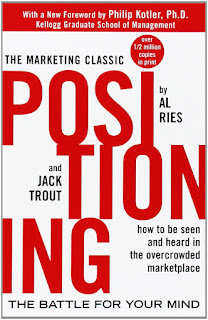I really enjoy Product Marketing a lot. I think it’s great fit for my skill set, but I just changed roles to the LinkedIn Sales Solutions Marketing Communications team. I’m following the principles from the Alchemist, abandoning what’s comfortable in an effort to grow and challenge myself. As part of that process, I asked my new manager if she recommend any books to help me in my new role. She recommended the marketing classic Positioning: The Battle for Your Mind by Al Ries and Jack Trout.
Here is a summary, notes and thoughts reading the book. My thoughts from a tech marketing perspective are in italics.
The authors make the point the society is over communicated. It’s harder than ever to change people’s mind, especially through a weak medium like advertising. The book was clearly written before the internet age, so it struck me that if it was a big problem when it was written, it’s a HUGE problem now.
Often, we look to the product for positioning, but in reality we should be thinking about what is already inside the prospect's mind. To succeed in positioning it’s got to be simple and related to what’s already in the customer’s mind or what they believe.
In positioning, there is huge first-mover advantage. In my opinion in technology, it’s not who is first, but the first to critical mass. Apple did not create the smartphone, but were the first to get critical mass. Facebook was not the first social network. Though, you might argue that MySpace had critical mass…..
It’s really hard to displace the leader who holds the number one position in the mind of the consumer. I think this is just as true in technology, it takes a long time or massively disruptive tech. Look at Microsoft. It is still the leader in so many categories, even with often inferior products.
If you’re going to do it, you must relate to the leader. The famous example is from Avis.
Typically, it’s a mistake to challenge the leader head on. Even Google with its almost infinite amount of money and brainpower could not take on Facebook head on with Google+.
Advice for market leaders
-Market leaders should not boast. This makes me think all of the chest pounding that happens after a Gartner Magic Quadrant or Forrester Wave comes out.
-Use a multi-brand strategy for new products. This is easier in a CPG company where the products are not related. At LinkedIn for example, we have products for recruiters, marketers and salespeople all built off the same social network, so it’s much harder to have a completely separate brand because they are all part of the same foundational network.
-Embrace new technologies. Duh.
Advice for followers
-Narrow your appeal. The first company that came to mind was Instagram, they only did pictures and that enabled them to not only compete, but eventually get bought by Facebook.
-Find a hole where you can be first. (Volkswagen “Think small” campaign”
Repositioning the competition
-Make people see the competitor in a different light. Salesforce did this effectively with the no-software campaign. It helped position Oracle as old and slow.
Naming
-Descriptive name is best. Zendesk is an interesting example. Alluding to a happy helpdesk.
-Names that will not limit expansion. The challenges of this I experienced first hand at Salesforce when I was marketing the Service Cloud. Company would say, I don’t need a sales product because of the name Salesforce. In hindsight we should have leaned exclusively on the product name instead of trying to leverage the company’s name.
-For non-product, names hard to oppose. “Clean Air Act”
-Don’t use initials for a name.
-Better to make a new name, then get a free ride on another brand. A brand can only occupy one position. This is challenge for us at LinkedIn.
Lastly, here are a few questions you should think about long and hard if you’re thinking of creating some new positioning.
What to our prospects already believe?
Am I a leader or follower? Be honest…
Where are the positioning gaps in our industry, what could we own?
Enjoy!
Here are two other summaries I found very helpful. One from QuickMBA and the other from Professor Mathur on Slideshare.
